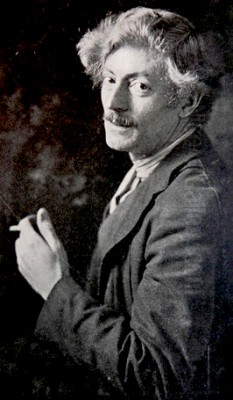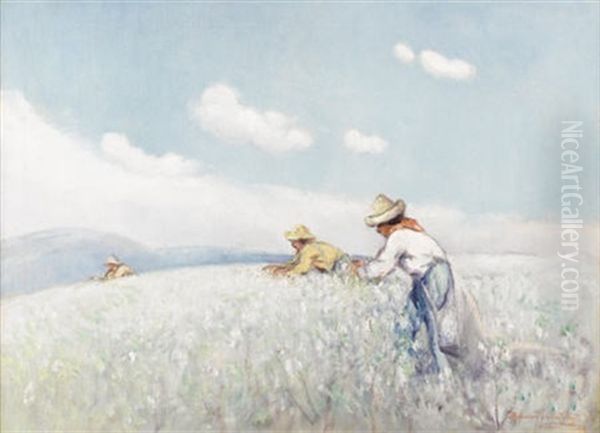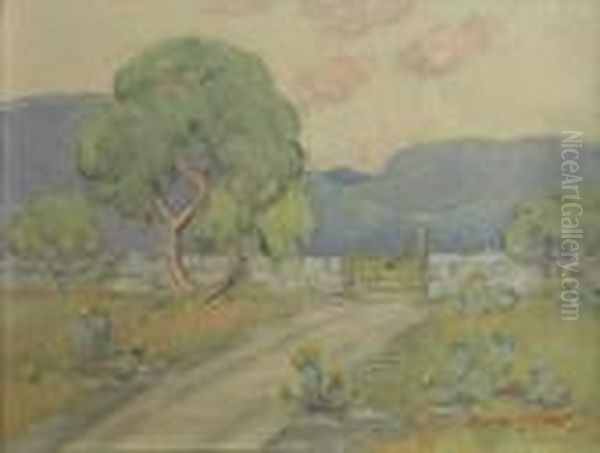
Dawson Dawson-Watson (1864-1939) stands as a significant, if sometimes overlooked, figure in the transatlantic art world of the late 19th and early 20th centuries. An English-born painter who carved out a distinguished career in the United States, he was a notable exponent of Impressionism, deeply influenced by his time in France, particularly at Giverny. His artistic journey took him from the hallowed halls of European academies to the vibrant, sun-drenched landscapes of Texas, leaving an indelible mark on the art scenes he inhabited, most notably in the American Southwest. His work is characterized by a sensitive engagement with light and color, a dedication to landscape, and a significant contribution to art education.
Early Life and Artistic Awakening in England
Born on July 21, 1864, in St. Pancras, London, Dawson Dawson-Watson was immersed in an artistic environment from his earliest years. His father, John Dawson Watson (1832-1892), was a highly regarded painter and illustrator associated with the Pre-Raphaelite Brotherhood and a prominent member of the Royal Watercolour Society. This familial connection undoubtedly nurtured young Dawson's artistic inclinations. He received his initial art education in England, demonstrating precocious talent that led to his works being exhibited at the prestigious Royal Academy in London while he was still a teenager. This early exposure to the formal art world of Victorian England provided him with a solid technical foundation upon which he would later build his more experimental Impressionistic style. His upbringing in a household where art was not just a profession but a way of life provided him with an invaluable apprenticeship, observing his father's techniques and the broader artistic currents of the time.
The artistic milieu of London during Dawson-Watson's formative years was a dynamic one, with traditional academic art coexisting alongside emerging movements. While the Royal Academy upheld classical standards, figures like James Abbott McNeill Whistler were challenging conventions, introducing aestheticism and an emphasis on tonal harmonies. Though Dawson-Watson would later embrace the brighter palette of Impressionism, these early London years grounded him in draughtsmanship and composition, skills that would remain evident throughout his career, even as his style evolved.
The Parisian Crucible: Immersion in Impressionism

Seeking to broaden his artistic horizons, Dawson-Watson, like many aspiring artists of his generation, traveled to Paris, the undisputed center of the art world in the late 19th century. Between 1886 and 1888, he immersed himself in the vibrant Parisian art scene, studying under several notable academic painters. His teachers included the celebrated portraitist Carolus-Duran, known for his bravura brushwork and as the tutor of John Singer Sargent. He also studied with Léon Glaize, Luc-Olivier Merson, and Raphaël Collin, all respected figures within the French academic tradition. This formal training further honed his technical skills, providing a counterpoint to the revolutionary artistic ideas percolating through the city.
It was during this Parisian sojourn that Dawson-Watson was profoundly exposed to Impressionism. The movement, which had scandalized the art establishment a decade earlier with artists like Claude Monet, Camille Pissarro, Edgar Degas, and Berthe Morisot, was by then gaining wider acceptance, though still considered avant-garde by many. The Impressionists' emphasis on capturing fleeting moments, the effects of light and atmosphere, and their use of broken brushwork and a brightened palette, resonated deeply with many younger artists, including Dawson-Watson. Paris offered him the chance to see their works firsthand and to engage with the ongoing debates about the future of art.
Giverny: Among the Impressionist Vanguard
Dawson-Watson's engagement with Impressionism solidified during his time at Giverny, the small village northwest of Paris that had become famous as the home of Claude Monet. From around 1887, Giverny began attracting a colony of artists, particularly Americans, drawn by Monet's presence and the picturesque Normandy landscape. Dawson-Watson became one of the earliest members of this burgeoning art colony, a testament to his early adoption of Impressionist principles. He resided there intermittently between approximately 1888 and 1893.
Living and working in Giverny placed Dawson-Watson at the heart of the Impressionist movement outside of Paris. He would have associated with other pioneering American Impressionists who flocked to the village, such as Theodore Robinson, who became a close confidant of Monet, as well as Willard Metcalf, Louis Ritter, Theodore Wendel, and John Leslie Breck. While Dawson-Watson reportedly maintained a degree of reserve regarding the almost cult-like reverence some artists held for Monet, the influence of the Impressionist master and the collective atmosphere of artistic experimentation at Giverny were undeniable. His Giverny period saw him produce works characterized by a bright palette, loose brushwork, and a focus on capturing the transient effects of light on the landscape, hallmarks of the Impressionist style, yet often retaining a strong sense of underlying structure and composition learned from his academic training.
Across the Atlantic: Early Forays in America

In 1888, Dawson Dawson-Watson made a significant life change, marrying Mary Hoyt Sellar and relocating to the United States. The couple initially settled in the Boston area before moving to Hartford, Connecticut. This move marked the beginning of his long and influential career in America. In Hartford, he quickly established himself as an artist and an educator, teaching art and actively promoting the principles of Impressionism through public lectures. His efforts to disseminate Impressionist ideas were important at a time when the style was still gaining traction in American art circles.
His work from this period began to reflect his new surroundings, though the Impressionist techniques honed in France remained central to his practice. He sought to capture the unique light and landscapes of New England, adapting his palette and approach accordingly. Despite achieving a degree of recognition within the local art community, Dawson-Watson found it challenging to secure a stable and suitable teaching position that met his ambitions. This difficulty, coupled perhaps with a desire to re-establish himself in his native country, led him to return to England for a period.
A Brief Return and a Permanent American Future
Dawson-Watson's return to England proved to be a temporary interlude. He found the artistic environment less conducive to his ambitions than he might have hoped, and his efforts to build a successful career there did not meet with the success he had found, or would later find, in America. The specific reasons for this are not extensively documented, but it's plausible that the British art scene, while having its own Impressionist adherents like Philip Wilson Steer and Walter Sickert, was perhaps more conservative or simply offered fewer opportunities for an artist with his particular background and evolving style at that time.
Recognizing that his future lay across the Atlantic, Dawson-Watson made the decision to return to the United States permanently in 1904. This move would prove pivotal, setting the stage for the most productive and recognized phases of his career. America, with its dynamic and expanding art scene, offered a more fertile ground for his talents as both a painter and an educator.
The St. Louis Years: Educator and Artist
Upon his return to the United States in 1904, Dawson Dawson-Watson secured a significant academic position as an instructor at the St. Louis School of Fine Arts at Washington University. He remained in this role for over a decade, until 1915. His tenure in St. Louis was a period of considerable activity, both as a teacher and a practicing artist. He played an important role in shaping the artistic development of numerous students, imparting the Impressionist techniques and aesthetic philosophies he had absorbed in Europe.
During his time in St. Louis, he continued to paint, likely focusing on the landscapes of Missouri and surrounding regions. This period also saw his involvement with the American Arts & Crafts Movement, a trend that emphasized craftsmanship, simple forms, and often, a connection to nature. While primarily a painter, his engagement with this movement suggests a broader artistic sensibility that valued the handmade and the integration of art into everyday life, a philosophy shared by figures like Gustav Stickley. His work from this era likely reflected a continued exploration of light and color, applied to the distinct character of the American Midwest. The St. Louis World's Fair of 1904, which coincided with his arrival, would have also provided a major artistic stimulus, showcasing international art and design.
Texas Beckons: A New Landscape, A New Vision
In 1915, Dawson Dawson-Watson made another significant move, this time to San Antonio, Texas. He would call this vibrant South Texas city home for the remainder of his life, until his death in 1939. The Texas landscape, with its unique flora, intense light, and vast expanses, offered him a rich new source of inspiration. He became particularly renowned for his depictions of the Texas Hill Country, its wildflowers, and especially its cacti, which he painted with a remarkable sensitivity to their sculptural forms and subtle coloration.
His arrival in San Antonio coincided with a burgeoning art scene. He became a prominent figure in Texas art, influencing a generation of regional artists. He was a contemporary of other notable Texas artists like Julian Onderdonk, famous for his bluebonnet landscapes, and Robert Jenkins Onderdonk (Julian's father), as well as the Spanish-born painter José Arpa, all of whom contributed to the development of a distinct Texas artistic identity. Dawson-Watson's Impressionist approach, adapted to the specific conditions of the Texas environment, brought a sophisticated, modern sensibility to the depiction of the region. He was captivated by the brilliant Texas sunlight and its effect on the landscape, a subject perfectly suited to his Impressionist training.
Artistic Style and Thematic Concerns
Dawson Dawson-Watson's artistic style is firmly rooted in Impressionism, yet it possesses individual characteristics that distinguish his work. He masterfully employed the core tenets of Impressionism: an emphasis on capturing the fleeting effects of light and atmosphere, the use of a bright, vibrant palette, and often, broken brushwork to convey immediacy and sensory experience. His landscapes, whether of Giverny, New England, or Texas, are imbued with a palpable sense of place and a keen observation of natural phenomena.
A recurring theme in his work is the depiction of nature, particularly flowers and plants. His Texas paintings of cacti are especially noteworthy. He moved beyond mere botanical illustration to capture the character and resilience of these desert plants, often setting them against dramatic skies or rugged terrain. Works like his numerous cactus flower paintings showcase his ability to combine delicate beauty with a sense of the wild. He also painted scenes of rural life, such as "Cotton Pickers," which demonstrates his interest in the human element within the landscape, a theme also explored by some French Impressionists like Pissarro and, in an American context, by artists like Winslow Homer, albeit in a different style. His compositions are generally strong, revealing the solid academic training that underpinned his more expressive Impressionistic technique. He also worked in watercolor, as evidenced by an "Untitled" watercolor noted for its bold composition, showing his versatility across media.
The "Glory of the Morning" and the Davis Competitions
A crowning achievement in Dawson Dawson-Watson's career came in 1927 when he won the prestigious Edgar B. Davis Competition, a series of art prizes sponsored by oilman Edgar B. Davis to encourage Texas artists to paint Texas wildflowers. Dawson-Watson's painting, "Glory of the Morning," a vibrant depiction of blooming prickly pear cactus in the early light, secured him the substantial $5,000 grand national prize, the largest cash award in American art at the time. This victory brought him national recognition and significantly enhanced his reputation.
The Davis Competitions, held in 1927, 1928, and 1929, were a major cultural event in Texas, stimulating artistic production and public interest in regional art. Dawson-Watson's success was not limited to the first year; he continued to win prizes in subsequent Davis Competitions, including first place in 1928 for "The Cactus Flower" (though some sources state it was for a painting of the huisache tree) and fifth place in 1929. These accolades cemented his status as a leading painter of the Texas landscape and a master of capturing its unique floral beauty. "Glory of the Morning" remains one of his most celebrated works, embodying his skill in rendering the intense light and vivid colors of the Texas environment through an Impressionist lens.
The Arts and Crafts Connection
Beyond his primary identity as an Impressionist painter, Dawson Dawson-Watson was also involved in the American Arts & Crafts Movement. This movement, which flourished from the late 19th century into the early 20th century, advocated for a return to hand-craftsmanship, simplicity in design, and the use of natural materials, as a reaction against mass-produced, overly ornate Victorian goods. It encompassed a wide range of media, from furniture and ceramics to metalwork and textiles, and its philosophy often emphasized the social value of art and the importance of beauty in everyday objects.
Dawson-Watson's connection to this movement is noted particularly during his time in St. Louis and his later period. While the specifics of his direct contributions to Arts & Crafts objects are less documented than his paintings, his involvement suggests an alignment with its principles. This might have manifested in a belief in the importance of skilled workmanship, an appreciation for natural forms and materials (evident in his landscape and floral paintings), or perhaps involvement in decorative projects or teaching crafts alongside fine arts. His dedication to art education also aligns with the Arts & Crafts ideal of disseminating artistic skills and appreciation more broadly.
Interactions with Contemporaries
Throughout his career, Dawson Dawson-Watson interacted with a wide array of prominent artists. His early tutelage under Carolus-Duran in Paris connected him to a lineage that included John Singer Sargent, a towering figure in portraiture. While their styles diverged, an early exchange with Sargent was noted, though their artistic paths later differed significantly. His time in Giverny brought him into contact with Claude Monet and the circle of American Impressionists there, including Theodore Robinson, Willard Metcalf, and John Leslie Breck, fostering an environment of shared artistic exploration.
Later in his American career, he reconnected with figures like Walter Pach, an influential artist, critic, and organizer of the groundbreaking 1913 Armory Show, which introduced European modernism to a wide American audience. Pach reportedly showed considerable interest in Dawson-Watson's work. He also knew Dudley Crafts Watson, an art lecturer and museum director. In Texas, he was part of a vibrant community that included Julian Onderdonk and José Arpa, contributing to the rich artistic dialogue in San Antonio. These interactions, whether as student, peer, or respected elder, underscore his engagement with the key artistic currents and personalities of his time.
Teaching and Lasting Influence
A significant aspect of Dawson Dawson-Watson's career was his dedication to art education. He held teaching positions in Hartford, Connecticut; at the St. Louis School of Fine Arts (Washington University) for over a decade; and later in San Antonio. Through these roles, he influenced countless students, introducing many to the principles of Impressionism and fostering their artistic development. His lectures on Impressionism in Hartford were among the early efforts to popularize the style in America.
His impact was particularly felt in Texas, where he became a respected elder statesman of the art community. His sophisticated technique, European training, and success in national competitions provided an inspiring model for local artists. He contributed to raising the profile of Texas art and helped to cultivate a regional school of landscape painting that celebrated the unique character of the Southwest. His legacy as an educator is intertwined with his artistic achievements, as he helped to shape the next generation of artists in the regions where he taught.
Personal Glimpses and Character
Dawson Dawson-Watson married Mary Hoyt Sellar in 1888, and their partnership spanned his moves across continents and within the United States. While detailed accounts of his private life are not abundant, some anecdotal evidence suggests a personality that could be passionate and perhaps somewhat eccentric. There are references to him being described with colorful, if informal, phrases suggesting a vibrant or intense character, sometimes even "mad as a hatter" or "mad as a coot," likely referring to his artistic fervor or unconventional ways rather than any literal instability. Such descriptions, common for artists perceived as deeply engrossed in their creative worlds, hint at a man of strong convictions and perhaps a theatrical flair, which may have also made him a compelling teacher.
His professional life was marked by a persistent dedication to his art, navigating the challenges of earning a living as an artist and educator across different cultural contexts. His willingness to relocate multiple times—from England to France, to the American East Coast, back to England, then to the American Midwest, and finally to the Southwest—speaks to a resilient and adaptive spirit, constantly seeking environments conducive to his artistic practice and professional growth. He passed away in San Antonio, Texas, in 1939, leaving behind a substantial body of work.
Legacy of a Transatlantic Painter
Dawson Dawson-Watson's legacy is that of a skilled and dedicated Impressionist painter who successfully bridged European artistic traditions with the evolving American art scene. He was an early adopter of Impressionism, particularly within the Giverny art colony, and played a role in introducing and popularizing the style in the United States through his painting and teaching. His work is celebrated for its vibrant color, sensitivity to light, and evocative depictions of landscape, from the fields of Normandy to the distinctive terrain of Texas.
In Texas, he holds a particularly esteemed place as one of an important group of artists who helped to define early Southwestern art, capturing the unique beauty of the region with an Impressionist's eye. His award-winning paintings of Texas wildflowers, especially "Glory of the Morning," remain iconic. Beyond his canvases, his long career as an art educator left a lasting impact on numerous students. Dawson Dawson-Watson's journey reflects the broader story of Impressionism's transatlantic passage and its adaptation to new environments, and his contributions ensure his place in the annals of both American and British art history.